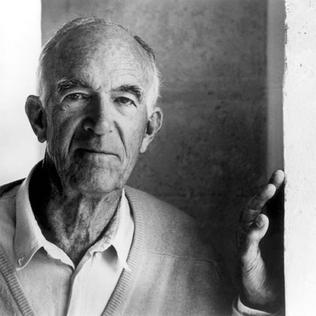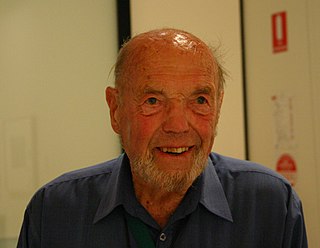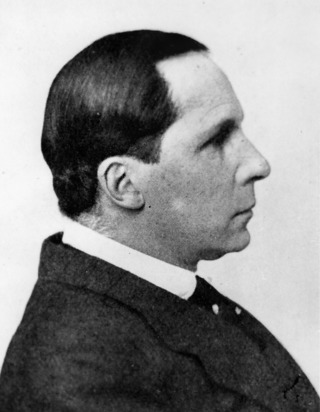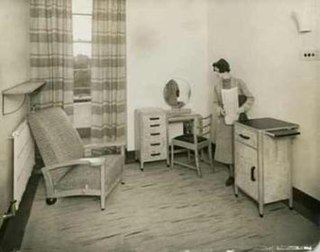Related Research Articles

Jørn Oberg Utzon was a Danish architect. In 1957, he won an international design competition for his design of the Sydney Opera House in Australia. Utzon's revised design, which he completed in 1961, was the basis for the landmark, although it was not completed until 1973.

Walter Burley Griffin was an American architect and landscape architect. He designed Canberra, Australia's capital city, the New South Wales towns of Griffith and Leeton, and the Sydney suburb of Castlecrag.
Denton Corker Marshall is an international architecture practice based in Melbourne, Australia.

Glenn Marcus Murcutt is an Australian architect and winner of the 1992 Alvar Aalto Medal, the 2002 Pritzker Architecture Prize, the 2009 American Institute of Architects Gold Medal and the 2021 Praemium Imperiale. Glenn Murcutt works as a sole practitioner without staff, builds only within Australia and is known to be very selective with his projects. Being the only Australian winner of the prestigious Pritzker Prize, he is often referred to as Australia's most famous architect.

William Hardy Wilson was an Australian architect, artist and author. He "is regarded as one of the most outstanding architects of the twentieth century".

Carlyle Greenwell was an Australian architect whose houses, designed in the first half of the 20th century, are often heritage-listed. He was also a philanthropist who made bequests to the University of Sydney funding research in Anthropology and Archaeology.

Wolfgang Georg Sievers, AO was an Australian photographer who specialised in architectural and industrial photography.
Bates Smart is an architectural firm with studios in Melbourne and Sydney, Australia. Founded in 1853 by Joseph Reed, it is one of Australia's oldest architectural firms. Over the decades, the firm's practices involving architecture, interior design, urban design, strategy, sustainability and research, have been responsible for some of Australia’s most recognizable buildings.

Daryl Sanders Jackson is an Australian architect and the owner of an international architecture firm, Jackson Architecture. Jackson also became an associate professor at University of Melbourne and Deakin University.

Harold Bryce Mortlock, LFRAIA, was an Australian architect and planner, alongside Sydney Ancher, Stuart Murray and Ken Woolley. His career spanned the era which saw the consolidation of modern Australian architecture.

Robert Smith (Robin) Dods was a New Zealand-born Australian architect.

Seabrook and Fildes was an Australian architecture practice in Melbourne, Victoria that played a significant role in the introduction of modernist architecture that first occurred in the 1930s. They are most well known for the Dutch modernist inspired Mac.Robertson Girls High School, designed by Norman Seabrook in 1933.

Percy Edgar Everett was an Australian architect. He was appointed chief architect of the Victorian Public Works Department in 1934 and is best known for the striking Modernist / Art Deco technical colleges, schools, hospitals, court houses, and office buildings the department produced over the next 20 years.

House at Caulfield, is a family home situated at 450 Dandenong Road in Caulfield North, Melbourne, Victoria, Australia, designed by Anatol Kagan in 1956 for Polish-Jewish emigre Leo Lind and his wife Dorothy. Born in Russian on October 4, 1913 Anatol Kagan's career as an architect spanned over seven decades until his death on July 2, 2009. He was actively involved in the field of design, as well as a writer, translator, lecturer and political activist. The house is an important work of its period demonstrating the Modernist architectural movement of Melbourne during the mid 20th Century, and in 2018 was added to the Victorian Heritage Register. Kagan was also influenced by the works of his local contemporaries, Roy Grounds, Frederick Romberg and Robin Boyd.

Mary Turner Shaw (1906–1990) was an Australian architect. She was born in Caulfield, Melbourne, Australia and is one of the first women to be employed as an architect in the early 1930s in Australia and thus pioneered new pathways for female architects. Her career is widely known for her working qualities that made her oversee many projects across Australia. She also became a distinct figure as an architectural historian, when she started publishing books and written articles. Her skills were diverse as she worked as a fashion designer, interior designer, project manager, public works architect and pioneer architectural librarian. As historian Geoffrey Serle described her, she was "a born writer and research historian with imagination, the ability to tell a story and define and ask fundamental questions".
Originally known as Stephenson and Meldrum (1921–1937), Stephenson and Turner (1938–1995) was a prominent Australian architectural firm, best known for the pioneering modernism of their numerous hospital designs of the 1930s and 1940s.
Ian Stapleton was an Australian heritage architect and a partner at Lucas, Stapleton, Johnson and Partners Pty Ltd. a heritage architectural firm in Australia. Stapleton carried out and contributed to heritage projects throughout Australia, including the Woolloomooloo Finger Wharf, Walsh Bay Redevelopment, the Sydney GPO and Officials’ houses at Port Arthur, Tasmania. He was also active in the National Trust of Australia, the NSW Heritage Council and Australia ICOMOS. Stapleton also published works on Australian architectural styles and was a visiting lecturer at various Sydney schools of architecture and building.
Ermin Smrekar (FAIA) was an Italian born Australian architect who practiced in Melbourne, Australia from the 1960s to the 1990s. He is known for designing outside the mainstream of Australian architecture in the period, his individual approach drew from organic architecture, angular and circular geometries, as well as historical sources, to create sometimes bold sculptural forms.

Henry Eli White, also known as Harry White, was a New Zealand-born architect best known for the many theatres and cinemas he designed in New Zealand and Australia in the 1910s and 1920s. Many of the major surviving historic venues in the two countries are White designs, including the St. James Theatre, Wellington, St. James Theatre, Auckland, the Capitol Theatre and State Theatre in Sydney, and the Palais Theatre and the interiors of the Princess Theatre and Athenaeum Theatre in Melbourne. He also designed the City Hall and the attached Civic Theatre in Newcastle, New South Wales.
Kingsley Anketell Henderson was an Australian architect and businessman. He ran a successful firm in Melbourne that specialised in commercial buildings. He was involved in the creation of the United Australia Party (UAP), holding office in its organisational wing in Victoria, and served on the Malvern City Council.
References
- 1 2 3 4 5 Reeves, Simon (Summer 2010). "Vale: Anatol Kagan" (PDF). Spirit of Progress. 11 (40): 25.
- 1 2 3 Built Heritage Pty Ltd. "Anatol Kagan". Dictionary of Unsung Architects. Retrieved 21 July 2012.
- ↑ "The late Anatol Kagan's Opera House dream". Montefiore Life. 24: 22. August 2009.
- ↑ "Anatol Kagan 1913- 2009". 9 July 2009. Retrieved 2 July 2011.
- ↑ Greenland, Hall. "A comrade to the end". The Age. Retrieved 27 July 2009.